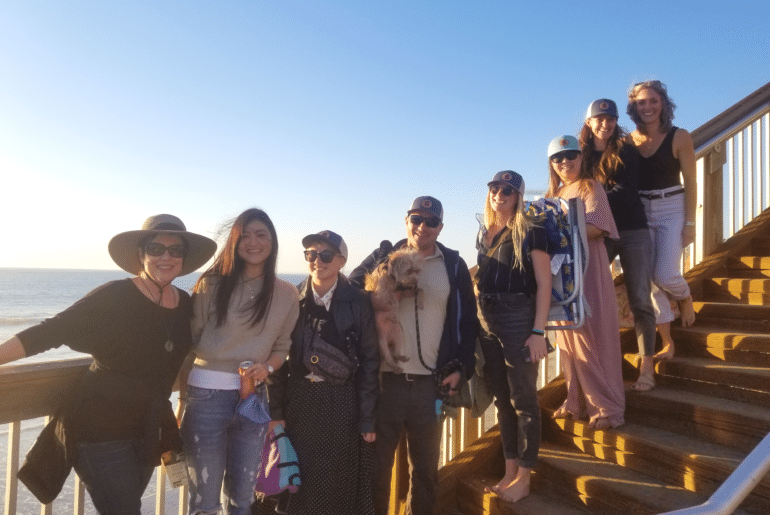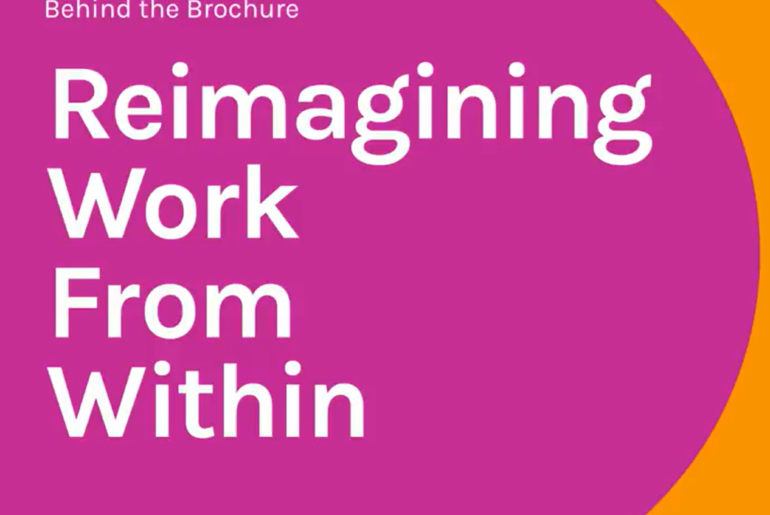For the past 18 years, the national average for employee engagement has remained around a measly 32%. That means that 7 out of 10 of the people reading this blog are not happy at work, the place we spend 40+ hours every week. Clearly, the engagement strategies we’ve been reading about in the Harvard Business Review and New York Times are not working, because they’re just bandaid solutions to a much deeper problem. Business is in need of a dramatic evolution to truly make work not feel like “work.”
Stok has made it our mission to achieve this, using nature as a guide. The concept of emulating nature’s genius is known as “biomimicry,” and is typically used in the design of buildings and products. Nature has had 3.8 billion years to design and adapt iterative solutions to the world’s problems. So why not use biomimicry to solve our organizational issues as well?
In May, we presented on this topic at the Living Future unConference with our friends at Biomimicry 3.8. Here, we outline 4 lessons from nature that you can apply to your organizational challenges, and what they’ve looked like for us in action at Stok.
LESSON #1: EVOLVE TO SURVIVE
In Nature
Evolution is change that spans across generations. There are typically three approaches to evolution that we see in nature:
1. Replicate strategies that work. As commonly explained, giraffes with longer necks were able to access more food from taller trees and therefore were able to produce more offspring that also had the long neck trait.
2. Integrate the unexpected. The wrinkled skin on elephants arose from a mutation, but it allowed the mammal to grow much larger due to having an increased surface area for heat loss.
3. Reshuffle information. Each time pollinators visit a flower, they’re exchanging genes that would have never previously crossed paths, providing an opportunity for something new to occur and increase diversity.
In Business
As we all know from 7th grade science class, organisms that fail to evolve end up extinct. This is true for companies as well. A 2016 report found that the longevity of S&P 500 companies has dramatically decreased in the past 50 years, from 65 years in 1965 to now 15. Just in the past seven years, some huge players have fallen off the list, including Eastman Kodak, Dell, and the New York Times, and have been replaced with newcomers like Facebook, PayPal, and Netflix. These new companies have done what others have failed to do – emulate nature’s genius by adapting and evolving to ever-changing markets.
For example, in the late 2000s, online streaming content threatened to make Netflix’s mail-order DVD rentals (the foundation of their business) obsolete. In response, Netflix evolved their business model to offer streaming content. Although they saw some dramatic short-term losses from this decision to replicate strategies that work, they are now the largest streaming company offering original content.
In Practice
Stok also went through an evolution. In 2015, we identified three issues that we anticipated may lead to our eventual extinction:
1. Our service offerings were limited. Although we had a diverse team of architects, engineers, and project managers, we were stereotyped as LEED consultants and so that was the work we continued to win. We realized that in order to get where we envisioned ourselves, we needed to expand our service lines. On top of Sustainability Consulting, we started offering Energy & Performance Engineering and Real Estate & Workplace Solutions to our clients, working on single buildings as well as across real estate portfolios. This revenue diversity has allowed us to continuously adapt to the ever-changing demands of the real estate market.
2. Our brand was stale. Our previous brand, “Environmental Building Strategies,” was too limited, and not attracting the types of clients we wanted to work with. So we integrated the unexpected by completely changing our name and launching a fresh, personal brand that better reflects our culture and values.
3. Most importantly, we weren’t taking care of our team members. As mentioned previously, engagement and retention are key to survival. Especially for a services-based company like Stok, people are our biggest asset. So we pinpointed the biggest sources of frustration, reshuffled information, and co-created a better way of doing business. Which leads us to…
LESSON #2: SELF-ORGANIZE
In Nature
Social insects like ants and bees accomplish amazing tasks such as venturing far to locate plentiful food sources and locating a favorable site for their new hive through self-organization and strong communication channels. There is no leader per se, rather they work as a well-coordinated team regularly sending signals and communicating with each other to constantly refine the information each is collecting. In a real sense, this is teamwork built on trust. Each carrying out their small but critical role and trusting that each is sending cues to the rest of the team so that, in the end, the best new food source or location for the hive is located and the colony collectively prospers.
In Business
It’s been found that companies that give their employees a “high level of freedom” are 10 to 20 times more likely to outperform companies with lower freedom scores. When thinking about freedom within Stok, we decided to go beyond the “work from home” and “unlimited vacation” initiatives (although we have those too!). We wanted each of our team members to truly have the flexibility and authority to influence both how they as individuals and how Stok as a whole does work. We were inspired by a book – Frederic Laloux’s “Reinventing Organizations” – which tells the stories of eight different companies that transitioned from hierarchical to self-managed organizational structures.
In Practice
For Stok, that meant restructuring the company into Teams based around our revenue lines. Each Team essentially operates as their own business – each creates and manages their own budget, hires and fires team members, sets annual goals, sells work, etc. While each team has leadership opportunities through specialized roles (e.g. the Cash Role is accountable for managing the Team’s budget and financial KPIs), there are no bosses. Instead, decisions are made by the group via dynamic governance, ensuring that all voices are heard while maintaining efficiency of decision making.
LESSON #3: INTEGRATE SHORT FEEDBACK LOOPS
In Nature
In nature, the most successful organisms are those that can deliver and collect instantaneous feedback. For example, a ripening apple releases the volatile plant hormone ethylene (the stimulus), which accelerates the reopening of ripe fruit in its vicinity so nearby fruit also ripens, releasing more ethylene (the response). All the fruit quickly becomes ripe together, proving the saying “one rotten apple spoils the whole bunch.”
In Business
However, when you look at organizational practices, feedback is far from instantaneous. Everyone’s favorite example of this is annual performance reviews. It’s been found that a whopping 90% of performance reviews are painful and ineffective. If you’ve ever participated in one of these reviews, you’re probably nodding your head right now. As a manager, it’s time consuming and difficult to fit a year of feedback into a one-hour performance review. And on the receiving end, it’s infinitely worse.
Why does this matter? Not only can poorly executed reviews decrease our favorite topic, engagement, but it turns out that feeling under-appreciated is THE number one reason for quitting. When researching performance reviews, we found three main factors that make them ineffective:
1. They’re annual. No one is ever going to improve from receiving feedback once a year. Feedback needs to be continuous and baked into a company’s culture to lead to individual growth.
2. They’re one-sided. Most review processes leave little to no room for the manager to receive feedback.
3. The wrong people are in the room. Very rarely is one person going to know everything you’ve been doing well, and everything that needs room for improvement.
In Practice
To combat these issues, companies are moving towards more informal, ongoing feedback mechanisms that align individual performance with the company’s values and purpose. We took some of these best practices and infused them with our unique Stok flavor to design our own feedback process around two main areas:
1. Monthly Recaps: Every month, each team member sits down with the one or two people they worked with the most that month for a peer-to-peer feedback session. It’s a two-way conversation, where each person talks about their achievements, their stressors, and gives feedback on how the other can improve.
2. Human Capital Contribution (HCC): Twice a year, each team member takes HCC surveys for the people they work most closely with, answering questions that evaluate performance in six key areas that provide long-term value to Stok: emotional intelligence, effective communication, work style, guidance, entrepreneurship, and relationships. The HCC scorecard results act as a guiding principle to examine how people are adjusting to the continual feedback they are receiving throughout the year.
LESSON #4: DEVELOP RECIPROCAL PARTNERSHIPS
In Nature
Mutualisms in nature can take many forms, yet are always defined as reciprocal partnerships where the success of one party supports the success of the other. A popular example is the clownfish and sea anemone. As we all know from Finding Nemo, sea anemone make a perfect home for clownfish by hiding them from predators, and in return, the clownfish provide free housekeeping, nutrition, and security services. By utilizing each other’s strengths, these species greatly improve their chances of survival.
In Business
In the workplace, we tend to expect each individual to be able to “do it all,” but what if we took a cue from nature, and formed mutual partnerships instead of trying to pick up a skill that doesn’t come as naturally to us? While it’s important to understand and work on your weaknesses, it’s equally important to devote time to your strengths.
In fact, being able to identify individual’s strengths and utilize them daily is proven to increase organizational success. When you’re using your strengths, you’re more likely to be engaged at work – and much less likely to leave. Individuals who use their strengths every day are 8% more productive and 15% more engaged.
In Practice
At Stok, we had a hard time finding a common language to describe our strengths. Then we discovered StrengthsFinder – an assessment that ranks 34 pre-defined strengths in order of how naturally they come to you. Now we know that the person that can easily distill complex information is high in “Communication,” and the Excel guru has “Analytical” in their top 5 strengths. Everyone’s results are transparent, so the Analyst can easily find the Communicator to pair up when it’s time to present on financial reports.
StrengthsFinder has also proven invaluable when forming balanced project teams. We can easily pull a report of the team’s strengths, and quickly pinpoint if it’s a well-rounded group – or see what’s missing if it isn’t. By finding these reciprocal relationships within Stok, each of us can focus on tending to and building upon our strengths, knowing there is someone to support us in our weaknesses.
While we won’t pretend to have all the answers, we hope that this will spark ideas and conversation around how to truly disrupt engagement at work. To see other example of nature’s genius, visit asknature.org and to learn more about biomimicry, visit biomimicry.net. And as always, if you’d like to discuss further, or have your own examples of organizational biomimicry to share, please get in touch!



